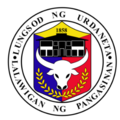Urdaneta | |
|---|---|
| City of Urdaneta, Lungsod ng Urdaneta, Siyudad ti Urdaneta, Siyudad na Urdaneta | |
Clockwise from top: Urdaneta Cathedral; Urdaneta Park Landmark Monument; Don Manuel N. Sison, Sr. Park; Old City Hall and Downtown Area | |
| Motto: Deo servire populo sufficere (It is enough for the people to serve God) | |
 Map of Pangasinan with Urdaneta highlighted | |
Location within the Philippines | |
| Coordinates: 15°58′34″N120°34′16″E / 15.9761°N 120.5711°E | |
| Country | Philippines |
| Region | Ilocos Region |
| Province | Pangasinan |
| District | 5th district |
| Founded | January 8, 1858 |
| Cityhood | March 21, 1998 |
| Named after | Andrés de Urdaneta |
| Barangays | 34 (see Barangays) |
| Government | |
| • Type | Sangguniang Panlungsod |
| • Mayor | Julio F. Parayno III (Independent) |
| • Vice Mayor | Jimmy D. Parayno (Independent) |
| • Representative | Ramon Guico, Jr. |
| • City Council | Members |
| • Electorate | 102,425 voters (2025) |
| Area | |
• Total | 100.26 km2 (38.71 sq mi) |
| Elevation | 50 m (160 ft) |
| Highest elevation | 899 m (2,949 ft) |
| Lowest elevation | 0 m (0 ft) |
| Population (2024 census) [3] | |
• Total | 145,935 |
| • Density | 1,455.6/km2 (3,769.9/sq mi) |
| • Households | 35,215 |
| Demonym | Urdanetanian |
| Economy | |
| • Income class | 1st city income class |
| • Poverty incidence | 16.31 |
| • Revenue | ₱ 1,483 million (2023) |
| • Assets | ₱ 3,485 million (2023) |
| • Expenditure | ₱ 1,349 million (2023) |
| • Liabilities | ₱ 890 million (2023) |
| Service provider | |
| • Electricity | Pangasinan 3 Electric Cooperative (PANELCO 3) |
| • Water | Urdaneta City Water District |
| Time zone | UTC+8 (PST) |
| ZIP code | 2428 |
| PSGC | |
| IDD : area code | +63 (0)75 |
| Native languages | Pangasinan Ilocano Tagalog |
| Website | urdaneta-city |
Urdaneta, officially the City of Urdaneta (Pangasinan : Siyudad na Urdaneta; Ilocano : Siyudad ti Urdaneta; Filipino : Lungsod ng Urdaneta), is a component city in the province of Pangasinan, Philippines. According to the 2024 census, it has a population of 145,935 people. [5] It is the third most populous local government unit (LGU) in Pangasinan and Ilocos Region. [6]
Contents
- History
- Cityhood
- Geography
- Barangays
- Climate
- Demographics
- Population
- Languages
- Religion
- Iglesia ni Cristo (Church of Christ)
- Economy
- Tourism
- Government
- Local government
- Elected officials
- List of mayors
- Culture
- Festivals
- Education
- Primary and elementary schools
- Secondary schools
- Colleges and universities
- Notable personalities
- References
- External links
As of January 1, 2025, it is the only 1st class city in Pangasinan. [7]




















